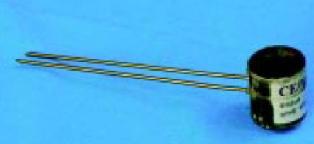SOUNDNESS
Soundness of cement is determined by Le-Chatelier method as per IS: 4031 (Part 3) – 1988.
Apparatus – The apparatus for conducting the Le-Chatelier test should conform to IS: 5514 – 1969
Balance, whose permissible variation at a load of 1000g should be +1.0g and Water bath.

Procedure to determine soundness of cement
i) Place the mould on a glass sheet and fill it with the cement paste formed by gauging cement with 0.78 times the water required to give a paste of standard consistency.
ii) Cover the mould with another piece of glass sheet, place a small weight on this covering glass sheet and immediately submerge the whole assembly in water at a temperature of 27 ± 2oC and keep it there for 24hrs.
iii) Measure the distance separating the indicator points to the nearest 0.5mm (say d1 ).
iv) Submerge the mould again in water at the temperature prescribed above. Bring the water to boiling point in 25 to 30 minutes and keep it boiling for 3hrs.
v) Remove the mould from the water, allow it to cool and measure the distance between the indicator points (say d2 ).
vi) (d2 – d1 ) represents the expansion of cement.
If you have a query, you can ask a question here.



materials very brief and need to be expanded especially details of experiments. on the whole the materials are good.
pls share soundness test on cement procedure by autoclave method
i want various method testing of cement with procedure & details as well as mehod of testing of aggregate with procedure
in this test the expansion should be limited with range of ———-
0 to 10 mm
how we carry out the strengh test of cement.
In the soundness test you have not mentioned the range of expansion of cement please mention it sir
Kindly mention range of expansion of cement paste in soundness test.
i have read all this exaplained in google. but here exaplain that soundness test conforms whether there will be any volume change in future or not or whether it will disintegrate or not. Can you any body exaplain me the actualy meaning of soundness test for cement and defination of soundness test?
hi, soundness of cement means that cement should not go any appreciable change in volume or simply u can say it should not expand..that is the soundness test to check the expansion of cemnt.
thanks alot, i am a student of civil engr. level 100 i need some civ engr softwares.
please give autoclave test procedure as possible.
what is the practical significance of this soundness test???
what if soundness is more..???
if the soundness is more than it will cause serious difficulties in durability of structure…
please give the method to prepare sample for autoclave that is the ratio of water and cement and curing of sample before putting it in the autoclave
please is it possible to have a video explanation of this test
What is the range of soundness
I think it is not more than 10%
total IS 4031
what is the significance of this test?
why we need leave the cement 24 hour before we measured the expansion
and half and hour for another reading…?
what do we mean by indicator points in soundess test? i don’t understand
what is soundness of cement and what is its purposes?
how can i calculate the quantity of cao in cement
The methodology explained is good but need more explanation specially for the practitioner who a actually involved in testing.